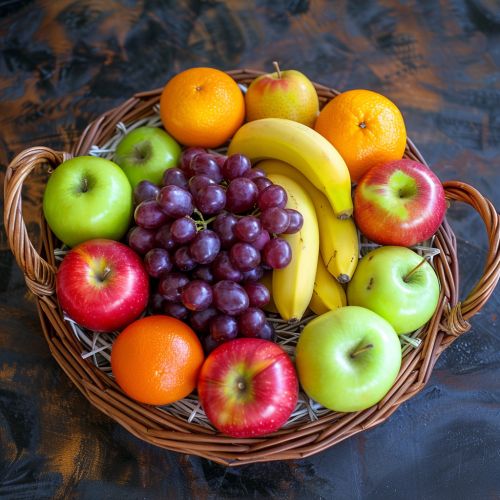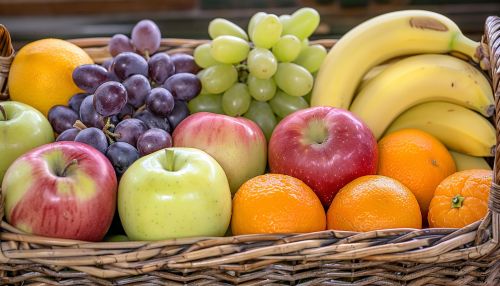Fruit
Introduction
Fruit, in the botanical sense, is the seed-bearing structure in flowering plants (angiosperms) formed from the ovary after flowering. Fruits are the means by which angiosperms disseminate seeds. Edible fruits, in particular, have long been a staple in the human diet and are integral to various culinary traditions and cultural practices globally.
Botanical Classification
Simple Fruits
Simple fruits develop from a single ovary of a single flower. They can be either fleshy or dry. Fleshy fruits include berries, drupes, and pomes. Dry fruits can be dehiscent (opening to release seeds) or indehiscent (not opening to release seeds).
- Berries: These are fleshy fruits without a stone, usually containing multiple seeds. Examples include tomatoes, grapes, and bananas.
- Drupes: These fruits have an outer fleshy part surrounding a single shell with a seed inside. Examples include cherries, peaches, and olives.
- Pomes: These fruits have a core of several small seeds, surrounded by a tough membrane. Examples include apples and pears.
Aggregate Fruits
Aggregate fruits form from a single flower with multiple ovaries. Each ovary develops into a small fruitlet, and together they form the aggregate fruit. Examples include strawberries, raspberries, and blackberries.
Multiple Fruits
Multiple fruits develop from the ovaries of multiple flowers growing in a cluster. Each flower produces a fruit, and these mature into a single mass. Examples include pineapples, figs, and mulberries.
Fruit Development
Fruit development begins with pollination, where pollen from the male part of the flower (anther) is transferred to the female part (stigma). Following successful pollination, fertilization occurs, leading to the development of seeds and the surrounding fruit tissue.
Hormonal Regulation
Hormones play a crucial role in fruit development. Auxins, gibberellins, and cytokinins are key hormones that regulate cell division, enlargement, and differentiation during fruit growth. Ethylene is particularly important in the ripening process of many fruits.
Nutritional Value
Fruits are rich in essential nutrients, including vitamins, minerals, fiber, and antioxidants. They are a significant source of vitamin C, potassium, and dietary fiber. The consumption of fruits is associated with numerous health benefits, including reduced risk of chronic diseases such as heart disease, cancer, and diabetes.
Phytochemicals
Fruits contain various phytochemicals, which are bioactive compounds that contribute to their health benefits. These include flavonoids, carotenoids, and polyphenols. For instance, anthocyanins found in berries have antioxidant properties, while lycopene in tomatoes is linked to reduced cancer risk.
Economic Importance
The fruit industry is a vital part of the global economy. Fruits are cultivated worldwide, with significant production in regions with favorable climates. Major fruit-producing countries include China, India, Brazil, and the United States. The industry encompasses various sectors, including farming, processing, distribution, and retail.
Trade and Export
Fruits are a major commodity in international trade. Exporting countries benefit economically from the global demand for fruits, while importing countries gain access to a diverse range of fruits year-round. Commonly traded fruits include bananas, apples, oranges, and grapes.
Cultivation and Harvesting
Fruit cultivation involves several practices to ensure high yield and quality. These include selecting appropriate varieties, managing soil health, irrigation, pest control, and pruning.
Harvesting Techniques
Harvesting techniques vary depending on the type of fruit. Some fruits, like apples and oranges, are harvested by hand, while others, like grapes, may be harvested using mechanical methods. The timing of the harvest is crucial to ensure optimal ripeness and quality.
Post-Harvest Handling
Post-harvest handling involves processes to maintain fruit quality and extend shelf life. This includes sorting, grading, packaging, and storage. Proper handling reduces post-harvest losses and ensures that fruits reach consumers in good condition.
Storage Conditions
Different fruits require specific storage conditions to maintain freshness. For example, cold storage is essential for apples and berries, while bananas are typically stored at higher temperatures to prevent chilling injury.
Cultural Significance
Fruits hold significant cultural and symbolic meanings in various societies. They are often associated with fertility, prosperity, and health. Fruits are also integral to many cultural rituals, festivals, and cuisines.
Symbolism
In many cultures, fruits symbolize abundance and fertility. For instance, pomegranates are often associated with fertility and prosperity in Middle Eastern cultures, while apples have symbolic meanings in various mythologies and religious texts.
Culinary Uses
Fruits are used in a wide range of culinary applications, from fresh consumption to cooking and baking. They are key ingredients in desserts, salads, sauces, and beverages. Traditional dishes often feature fruits, reflecting their cultural importance.
See Also


